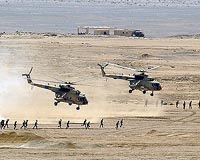| . |  |
. |
Beirut, Lebanon (UPI) Aug 25, 2009 Middle Eastern countries are expected to spend more than $100 billion over the next five years, largely because of growing fears about Iran's nuclear program and its perceived ambition to undermine Sunni-led Arab regimes, according to an assessment by a U.S.-based consultancy. Most of the procurement will be carried out by Saudi Arabia, the United Arab Emirates, Iraq and Israel, the New York-based Scott & Sullivan consulting firm said in the report released Sunday. The core of this arms-buying spree will undoubtedly be the $20 billion U.S. package of weapons systems over 10 years for the six states of the Gulf Cooperation Council -- Saudi Arabia, the U.A.E., Kuwait, Oman, Qatar and Bahrain. Egypt, another key U.S. ally, is to get a $13 billion package. Israel, in exchange for agreeing to Washington providing the Gulf states with state-of-the-art weaponry it had traditionally sought to block, will get an arms package worth an estimated $30 billion over 10 years -- a 25 percent increase over previous levels. These unprecedented packages were unveiled by President George W. Bush in January 2008 to counter Iran -- even though the Islamic Republic's spending on conventional military forces is substantially less than it was two decades ago. Critics of the U.S. arms plan say that the provision of advanced weapons systems to the Arab states, including precision-guided munitions that once were taboo for the Arabs, will only encourage Iran to increase its militarization in a region already highly militarized. "Even by the standards of past arms sales to the Middle East and Persian Gulf, traditionally one of the world's largest arms-buying regions, these are major arms transfers with the potential to significantly affect the regional strategic balance," says U.S. military analyst David Isenberg. Critics note, too, that the United States is largely to blame for the current situation -- Iran's recent expansionist ambitions were the result of the Bush administration eliminating Tehran's enemies in neighboring Iraq and Afghanistan. And in that regard, another fear prevalent among the Gulf Arabs is that Iraq will collapse into civil war as the Americans withdraw their forces, and that the violence will likely spill over into GCC territory. According to the Frost & Sullivan report, Saudi Arabia spent around $36 billion on arms in 2008, mostly from the United States, and it's expected to fork up about the same amount this year. Israel, whose technological edge over its Muslim neighbors successive U.S. administrations have pledged to maintain, will have spent around $13 billion by the end of this year, the report said. "Israel's spending has been quite consistent as it has built a very effective and modern military with the most cutting-edge technologies," it noted. "It is still expected to keep spending to stay ahead of its regional adversaries in order to protect its interests." The systems involved in the transfers listed in 2008 span virtually every facet of conventional arms. In July, Israel submitted an official Letter of Request to the U.S. Department of Defense to buy its first squadron of F-35 stealth fighter aircraft, also known as the Joint Strike Fighter, built by Lockheed Martin. The 25 jets, which will probably be the last manned fighter ever built, will cost an estimated $100 million. Israel wants to purchase another 50, some with vertical takeoff and landing capability, as well as two new missile ships. Saudi Arabia and the U.A.E., whose air force with its mix of 120 U.S. and French combat strike jets and interceptors is considered a powerful arm, are both interested in strengthening their air power, their primary defense against Iran. Saudi Arabia is also reportedly discussing the purchase of more Eurofighter Typhoons from Britain to double its current fleet of 72, acquired in 2006. Riyadh also wants more F-15S Eagles from Boeing. Saudi Arabia and the U.A.E. also want a wide range of military platforms, with particular interest in missile defense systems such as the U.S. Theater High Altitude Air Defense system. Approval was recently given for the Pentagon to sell this to the U.A.E., THAAD's first foreign customer. Iraq, which is building up its military forces as the Americans withdraw, is expected to invest heavily in its armed forces over the next decade or more and could spend up to $11 billion by 2014, the report said. The Baghdad government has to rebuild its military forces pretty much from scratch following the overthrow of Saddam Hussein's regime in 2003. Share This Article With Planet Earth
Related Links The Military Industrial Complex at SpaceWar.com Learn about the Superpowers of the 21st Century at SpaceWar.com
 Russia, Saudi Arabia near deal on helicopter sale: report
Russia, Saudi Arabia near deal on helicopter sale: reportMoscow (AFP) Aug 25, 2009 Saudi Arabia is close to signing an agreement to purchase 30 Mi-171B military transport helicopters from Russia, a source familiar with the talks was quoted as saying on Tuesday. "We are in the final stage of negotiations on the purchase of a shipment of 30 helicopters and hope to sign an agreement in September," the source told Russia's RIA-Novosti news agency. The Mi-171B is a large ... read more |
|
| The content herein, unless otherwise known to be public domain, are Copyright 1995-2009 - SpaceDaily. AFP and UPI Wire Stories are copyright Agence France-Presse and United Press International. ESA Portal Reports are copyright European Space Agency. All NASA sourced material is public domain. Additional copyrights may apply in whole or part to other bona fide parties. Advertising does not imply endorsement,agreement or approval of any opinions, statements or information provided by SpaceDaily on any Web page published or hosted by SpaceDaily. Privacy Statement |